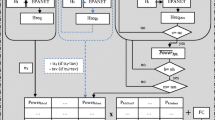Abstract
A model for optimal operation of water supply/irrigation systems of various water quality sources, with treatment plants, multiple water quality conservative factors, and dilution junctions is presented. The objective function includes water cost at the sources, water conveyance costs which account for the hydraulics of the network indirectly, water treatment cost, and yield reduction costs of irrigated crops due to irrigation with poor quality water. The model can be used for systems with supply by canals as well as pipes, which serve both drinking water demands of urban/rural consumers and field irrigation requirements. The general nonlinear optimization problem has been simplified by decomposing it to a problem with linear constraints and nonlinear objective function. This problem is solved using the projected gradient method. The method is demonstrated for a regional water supply system in southern Israel that contains 39 pipes, 37 nodes, 11 sources, 10 agricultural consumers, and 4 domestic consumers. The optimal operation solution is described by discharge and salinity values for all pipes of the network. Sensitivity of the optimal solution to changes in the parameters is examined. The solution was found to be sensitive to the upper limit on drinking water quality, with total cost being reduced by 5% as the upper limit increases from 260 to 600 mg Cl l−1. The effect of income from unit crop yield is more pronounced. An increase of income by a factor of 20 results in an increase of the total cost by a factor of 3, thus encouraging more use of fresh water as long as the marginal cost of water supply is smaller than the marginal decrease in yield loss. The effect of conveyance cost becomes more pronounced as its cost increases. An increase by a factor of 100 results in an increase of the total cost by about 14%. The network studied has a long pipe that connects two distinct parts of the network and permits the supply of fresh water from one part to the other. Increasing the maximum permitted discharge in this pipe from 0 to 200 m3 h−1 reduces the total cost by 11%. Increasing the maximum discharge at one of the sources from 90 to 300 m3 h−1 reduces the total cost by about 8%.
Similar content being viewed by others
References
Cohen D. 1991. Optimal operation of multiquality networks. D. Sc. Thesis, Faculty of Agricultural Engineering, Technion, Israel (In Hebrew), p. 400.
Cohen D., Shamir U. & Sinai G. 2000a. Optimal operation of multiquality water supply systems: I. Introduction and the Q–C Model. Engineering Optimization 32: 549–584.
Cohen D., Shamir U. & Sinai G. 2000b. Optimal operation of multiquality water supply systems: II. The Q–H Model. Engineering Optimization 32: 687–719.
Cohen D., Shamir U. & Sinai G. 2000c. Optimal operation of multiquality water supply systems: III. The Q–C–H Model. Engineering Optimization 33: 1–35.
Cohen D., Shamir, U. & Sinai G. 2003. Comparison of models for optimal operation of multiquality water supply networks. Engineering Optimization 35(6): 579–605.
Jury W.A., Sinai G. & Stolzy L.H., 1980. A proposal for reclamation by dilution of irrigation water. Irrigation Science 1: 161–168.
Liang T. & Nahaji S. 1983. Managing water quality by mixing water from different sources. Journal Water Resources Planning and Management ASCE 109(1): 48–57.
Maas E.V. & Hoffman G.J. 1977. Crop salt tolerance–Current assessment. Journal of Irrigation and Drainage ASCE 103: 115–134.
Males R.M., Clark R.M., Weahrman P.J. & Gates W.E. 1985. Algorithm for mixing problems in water systems. Journal of Hydrologic Engineering ASCE 111(2): 206–216.
Mehrez A., Percia C. & Oron G. 1992. Optimal operation of a multi-source and multiquality regional water systems. Water Resources Research 28(5): 1199–1206.
Oron G. 1987. Marginal water application in arid zones. Geology Journal 15(3): 259–266.
Ostfeld A. & Shamir U. 1993a. Optimal operation of multiquality networks: I. Steady-state conditions. Journal of Water Resource Planning and Management ASCE 119(6): 645–662.
Ostfeld A. & Shamir U. 1993b. Optimal operation of multiquality networks, II: Unsteady conditions. Journal of Water Resource Planning and Management ASCE 119(6): 663–684.
Percia C., Oron, G. & Mehrez A., 1997. Optimal operation of regional system with diverse water quality sources, Journal of Water Resource Planning and Management ASCE 123(2): 105–115.
Pessen D., Reike M. & Sinai G., 1986. Design and simulation of water mixing junctions in irrigation systems. International Journal of Model and Simulations 6(1): 32–38.
Pessen D., Sinai G., Fasol K.H. & Reike M., 1989. Design of dilution junctions for water quality control, Journal of Water Resource Planning and Management ASCE 115(6): 829–845.
Reike M., Fasol K.H., Sinai G. & Pessen D., 1987. Hierarchical control of multiquality water distribution systems. Computers and Electronics in Agriculture 2: 1–13.
Schwartz J., Meidad N. & Shamir, U. 1985. Water Quality Management in Regional Systems (pp. 341–349), Proceedings of Jerusalem Symposium on Science, Basis for Water Resource Management, IAHS Publication No. 153.
Shah M. & Sinai G., 1985. Salinity control in multi-quality irrigation networks – Kibbutz Hamadia feasibility study. Agriculture Water Management 10: 235–252.
Sinai G., Kock E. & Farbman M., 1985a. Dilution of brackish waters in irrigation networks – An analytical approach. Irrigation Science 6: 179–190.
Sinai G., Jury W.A. & Stolzy L.H. 1985b. Application of automated flow and salinity control to dilution of saline irrigation water. Irrigation Science 6: 27–36.
Sinai G., Shina G., Kitai E. & Shah M. 1987. Physical and computer models of multi-quality networks. Journal of Water Resource Planning and Management ASCE 113(6): 745–760.
Author information
Authors and Affiliations
Rights and permissions
About this article
Cite this article
Cohen, D., Shamir, U. & Sinai, G. Sensitivity analysis of optimal operation of irrigation supply systems with water quality considerations. Irrig Drainage Syst 18, 227–253 (2004). https://doi.org/10.1007/s10795-004-9145-y
Issue Date:
DOI: https://doi.org/10.1007/s10795-004-9145-y




